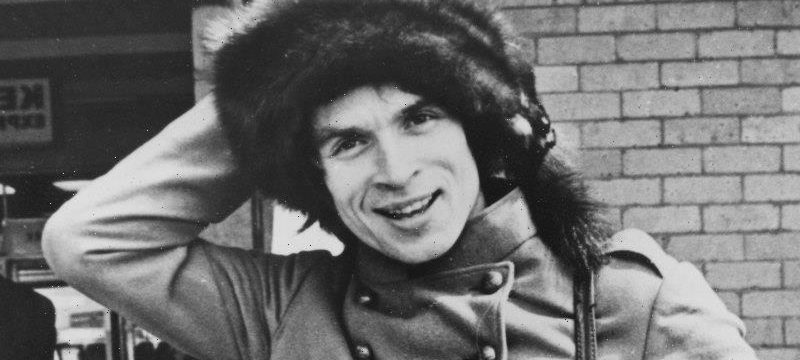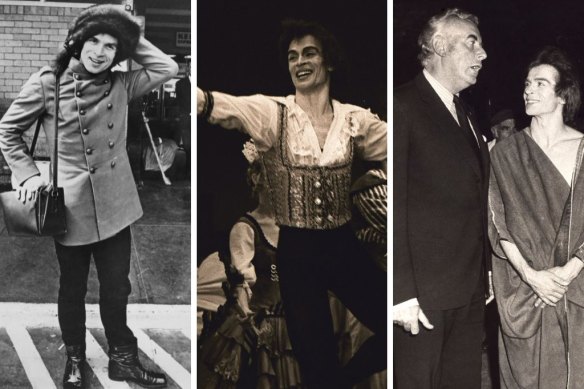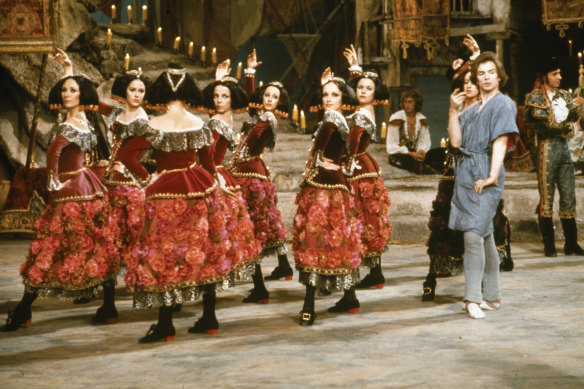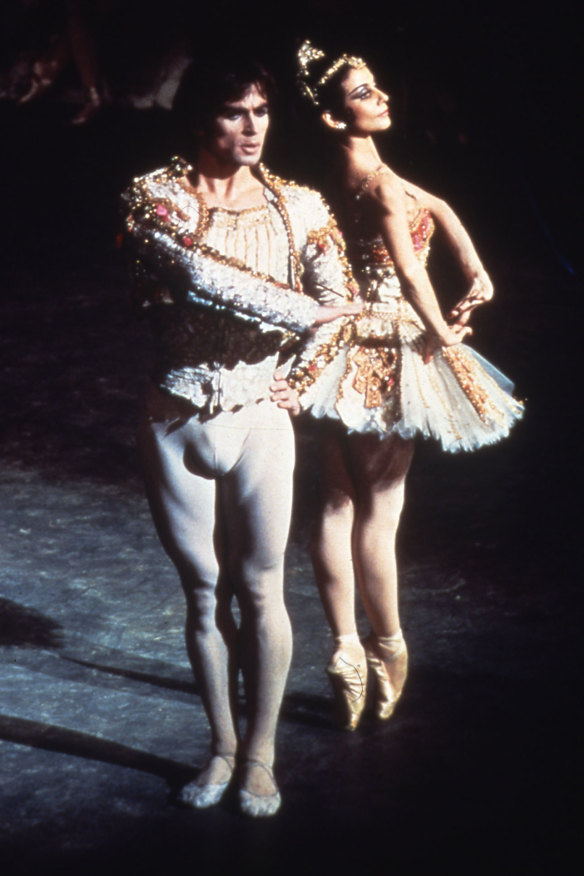By Amanda Dunn
From left, Rudolf Nureyev arriving in Melbourne for rehearsals in 1970; on stage in Don Quixote; with then Prime Minister Gough Whitlam. Credit:
In 1962, when the newly formed Australian Ballet was introducing itself to audiences, it had a major coup: arguably the greatest – and certainly most famous – male ballet dancer of the time, Rudolf Nureyev, came to Australia to visit Danish star Erik Bruhn, who was a guest of the young company. It was the start of Nureyev’s love affair with the Australian Ballet. He returned to the company to dance several times, and ultimately teamed up with local dance and theatre star Sir Robert Helpmann to create a film version of Don Quixote with the company in 1972.
Frank Croese, who was a soloist in the company when the film was shot, says it is hard to overstate the impact of Nureyev’s enormous star power.
“He brought ballet to the forefront – he put it on the front page,” he says. “The audience suddenly sat up and took notice. I mean, it was the start of the Australian Ballet in some ways.”
By the time Nureyev landed on our shores, a year after he had spectacularly defected from Russia at the height of the Cold War, he was already an international star. Charismatic and volatile as well as a superb dancer, Nureyev drew attention wherever he went, particularly once his partnership with one of the world’s most beloved ballerinas, Margot Fonteyn, had taken the ballet world by storm. So choosing to make his Don Quixote with the Australian Ballet was a huge deal.
Rudolf Nureyev with Australian Ballet dancers during rehearsals at Essendon Airport. Credit:Paul Cox
Shot in a repurposed airline hangar at Essendon Airport over 25 days in 1972 and released the following year, it went on to be one of the most successful ballet films of all time. Now, 50 years after the film and 60 years after the company began, the Australian Ballet is translating Nureyev’s rendition of the classic story for the stage for the first time, with new sets and costumes adapted from the film.
Based on the Cervantes novel and Marius Petipa’s original 1869 choreography, Don Quixote tells the story of barber Basilio’s fervent love for Kitri, and his determination to win her hand in marriage, despite her father’s desire for her to marry foppish nobleman Gamache. Along the way, Basilio enlists the help of a visionary knight and his sidekick, Sancho Panza. The witty, rollicking story belies the technical difficulty of the ballet for the dancers.
“The Nureyev versions [of any ballet] are very, very difficult technically,” says Australian Ballet artistic director David Hallberg. “He really loved to show off his technical prowess in a way. He amplified and really made the steps even more difficult.”
It wasn’t just the steps that Nureyev made difficult. Croese played Kitri’s father Lorenzo in the film version – largely an acting role – and remembers how exacting “Rudy”, who not only directed but also danced the lead role of Basilio, was about every detail of the film.
Rudolf Nureyev and Lucette Aldous in Don Quixote in 1972.Credit:Fairfax
One example was when Kitri, danced by Lucette Aldous, famously does 32 fouettés in a row: this requires the dancer to pirouette, on pointe, while whipping her leg out to the side and then pulling it in on each turn. She also, preferably, stays on one spot while doing so, without “travelling”. It is one of the most difficult steps for a dancer to execute – particularly 32 in a row.
Aldous performed her fouettés immaculately, then Nureyev came on to do his spectacular turns. But he wasn’t happy with them, so he made everyone do them again. And again. Not just his bit, but Aldous’ fouettés as well. The pair must have done their turns three or four times, Croese says, and when Nureyev was finally happy, everyone cheered.
“My god, he made everyone else miserable when things weren’t working for him,” Croese recalls, chuckling. “He made sure they weren’t working for you either!”
Marilyn Rowe was a young dancer in the company who would go on to become one of its most beloved performers. She had the dual roles of street dancers and Queen of the Dryads in the film, and remembers how demanding the 25 days of filming in stifling heat were, with the dancers often working from 7am to 10.30pm. She also recalls how demanding Nureyev could be.
“He was very complex, he was an enigma. He was at once humorous, extremely funny, incredibly intelligent, a perfectionist. But volatile, very volatile,” she recalls. “I mean these sort of people only come along once in a while in our history.”
Much thought had been given to the look of the sets, which recreated a Spanish marketplace. Everything was real, including the candles in the tavern scene, which specularly set fire to a dancer’s costume one day, fortunately without causing injury. Extras had been brought in from the Victoria Market, along with their produce, and in the long periods when Croese was not required on set, he would head outside and sit in the shade, chatting with the extras. It was a masterstroke on Nureyev’s part, he says, because it gave the film an authentic look.
Despite being difficult at times, Nureyev gave much to the young company and its dancers. As well as the pull of his huge star power, he could also be kind-hearted and generous, Rowe says. His eye for detail and perfectionism rubbed off on them. “He basically brought us up by our boot straps in that we were forced to do more than we thought we could do.”
Nureyev also revolutionised the role of the male dancer in ballet: where once they were background figures, there largely to show off the ballerina, Nureyev made them far more equal performers. He injected a very masculine sexuality into much of his dancing, and audiences loved it. Hallberg says this is apparent in Don Quixote, where Basilio has more solos than the male lead in other ballets might. Nureyev was constantly pushing the artform and its dancers with his talent, charisma and capacity for hard work.
Ultimately, he gave the young company a profound gift, Rowe says: “He made everybody better dancers and artists.”
Don Quixote is at Melbourne’s State Theatre, March 15-25, and Sydney Opera House, April 8-25. https://australianballet.com.au/
Most Viewed in Culture
Source: Read Full Article



